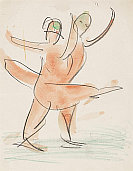
Félicien Joseph Victor Rops
1833 Namur (Belgien)
1898 Essonnes (heutige Corbeil- Essonnes)
The Belgian painter, etcher, and lithographer Félicien Joseph Victor Rops was born on July 7, 1833 in Namur. He came from a wealthy family. After Rops registered at the academy in Namur in 1849, he entered the Université Libre de Bruxelles in 1851. He was associated with the circles of intellectuals, pamphleteers, and artists.
He discovered his artistic talent as an illustrating staff member of the student magazine "Le Crocodile". Under the influence of Paul Gavarni (1804 – 66) and Honoré Daumier (1808 – 79), Rops drew 135 political and social caricatures. Joseph Victor Rops published these in the "Uylenspiegel", co-founded in 1856 with Charles de Coster (1827 – 79), and later in "Charivari belge". He’s first works "La peine de mort", "L'ordre règne à Varsovie", and "La médaille de Waterloo" express the artist’s displeasure at the deplorable state of affairs during his age. Some of his larger individual sheets were "Jew and Christian" (1857), "Peace Prevails in Warsaw" (1863), "Burial in the Walloon Land" (1864), "With the Tappists", and "Un monsieur et une dame".
In 1857, he married Charlotte Polet, the daughter of a jurist from Namur. The Paris doors opened to him through the recognition by many artists. Between his many journeys, he learned various engraving techniques (soft-ground etching, dry-point and aquatint techniques) and visited the meetings of the "Société des Aquafortistes" here. With the help of the publisher Auguste Poulet-Malassis (1825 – 78) in Namur, Joseph Victor Rops meet Charles-Pierre Baudelaire (1821 – 67) and designed the latter’s frontispiece for "Les épaves" in 1866. In 1868, the artist actively participated in the founding of the "Société Libre des Beaux-Arts in Brussels" and became its vice-president. He also established the "Société International des Aquafortistes" in the following year in Brussels.
In 1874, Joseph Victor Rops moved permanently to Paris and lived here with the Dulud sisters Aurélie and Léontine. The artist was the best-paid illustrator in Paris at this time. Starting in 1874, he illustrated the works of Théophile Gautier (1811 – 72), Alfred de Musset (1810 – 57), Stéphane Mallarmé (1842 – 98), Charles Baudelaire, Jules Amédée Barbey d'Aurevilly (1808 – 89), and Octave Uzanne (1852 – 1931). He also continued to go on many journeys to Norway, Sweden, Spain, Hungary, America, and Canada. From this time on, he concentrated on painting.
In 1886, Rops met Armand Rassenfosse (1862 – 1934), with whom he later became friends. Together they developed an engraving technique and invented a transparent dry-point process, the ropsenfosse process. In 1888, he received the Order of the French Legion of Honor.
The artist spent the last ten years at his country estate in Essonnes (now Corbeil-Essonnes) in the south of Paris. He suffered from poor eyesight, dedicated himself to his passion for botany and discovered new species of roses.
Félicien Joseph Victor Rops died on August 23, 1898 in Essonnes. His home town of Namur opened the Félicien Rops Museum in 1964.

Would you like to sell a work by Félicien Joseph Victor Rops?
Infos for sellerART MARKET:
No items found for this artist.






